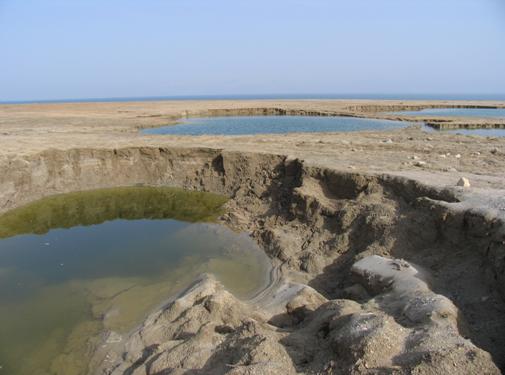A team of researchers from Israel, Jordan and France tested methods for locating sinkholes in the early stage of their formation. Dr. Lev Appelbaum from Tel Aviv University explains how they managed to locate sinkholes with a diameter of 2-3 meters, before they turn into tens of meters of monsters.

Last Friday, a hiker fell into a sinkhole that is about 20 meters deep near Nahal Darga in the north of the Dead Sea. Megilot unit personnel and an Air Force helicopter were launched to the area. After a few hours, the man was rescued in a serious condition, unconscious and taken to a hospital by helicopter.
Dr. Lev Applebaum, senior research fellow, Department of Geophysics and Planetary Sciences, Faculty of Exact Sciences, Tel Aviv University, together with his international colleagues under the auspices of the "Science for Peace" program of NATO (North Atlantic Alliance), developed the new method For the early detection of the formation areas of pits along the shores of the Dead Sea. Thousands of sinkholes have been opened along the shores of the Dead Sea in Israel and Jordan during the last two decades. Such a pit develops at a depth of 50-25 m below the surface following the drop in the level of the Dead Sea at a rate of 1.0-0.8 m/year. This phenomenon constitutes a very serious risk and causes heavy damage to citizens, tourism and property in the Dead Sea region.
The new method is based on complex measurements of the gravity changes in the micro scale on the surface. Measuring the density differences between the pit area and the environment with the modern measuring equipment, allows early detection of gravity anomalies, caused by small and invisible pits. As a result of implementing this new system, it is possible to discover and locate potholes before their final development.
In a conversation with the Hidan site, Dr. Appelbaum says that the funding for the research was provided by NATO, and it was actually carried out by scientists from Israel, Jordan and France, who, as mentioned, studied methods for early detection of sinkholes on the coastline of the Dead Sea from both Israel's and Jordan's sides.
"We applied geospatial methods from Sapir. The main method is the measurement of gravity, and in addition to it a magnetic method, a seismic measurement method, and an electrical method based on the study of the resistance between the sinkholes and the environment. These are underground caves, empty or filled with water. In both cases we have differences in the physical properties between the target and the surrounding soil.
The French geophysicists implemented an NMR (nuclear resonance) system. This is a relatively new method in the field of geophysics, and it has not yet been applied to the study of sinkholes. Thanks to the combination of the methods, we uncovered new sinkholes in different areas, and more importantly - several times we uncovered the sinkholes at an early stage of development. These are sinkholes with diameters of 3-4 meters. To illustrate, every year they grow by 10 meters.
What was your part in the project?
Dr. Applebaum: "I specialize in the gravitational method and the magnetic method. In an article we recently published in Advances in Geoscience, we presented how it is possible to demonstrate the use of heavy analysis, on sinkholes. We applied the gravity method by testing the surface at ground level, with a resolution of two meters from one test point to another, when in the areas close to hotels, roads and factories, we activated the equipment every meter. I would like to emphasize that this is not equipment that we designed or built, but the methodology that we applied is the result of our developments. These are mainly stages of processing and interpretation of gravity fields, including three-dimensional models adapted to the complex geological conditions that exist in the Dead Sea."
Appelbaum would like to thank his research partners, especially the team of the Israel Geophysical Institute in Lod led by Dr. Michael Yezhersky who devotes a lot of time and resources to the study of sinkholes, as well as Anatoly Legchenko from the University of Grenoble. in France
The results of the study were recently published in:
Eppelbaum, LV, Ezersky, MG, Al-Zoubi, AS, Goldshmidt, VI and
Legchenko, A., 2008. Study of the factors affecting the karst volume
assessment in the Dead Sea sinkhole problem using microgravity field
analysis and 3D modeling. Advances in GeoSciences, 19, 97-115.

7 תגובות
Peace be upon you
Why won't the spinner spin
The new Minister of Infrastructure must work vigorously to build a canal between the Red Sea and the Dead Sea
Instead of wasting money on nonsense, maybe you will return the water to the Dead Sea and then the sinkhole problem will be solved once and for all.
A person who believes that everything in nature has a reason and revolves around the reason.
By the way, the research reviewed in the article also did not apply a detection method using a laser, which was developed at the time by researchers from the Technion and according to an article published in Hidan (10.05.07) proved impressively effective. I wonder why.
It seems that these are sophisticated methods with high sensitivity. Can these methods be applied in any combination or with any changes and adjustments to locate tunnels used by Hamas for the purpose of transferring supplies from Egypt to Gaza, or tunnels that are supposed to be used as inferno tunnels?
eat-swallow